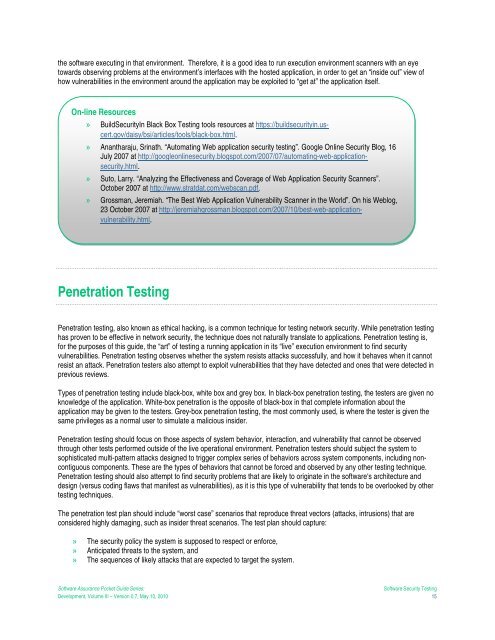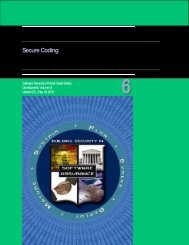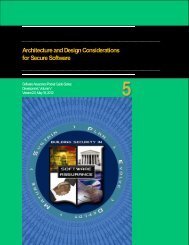Risked Based Software Security Testing - Build Security In - US-CERT
Risked Based Software Security Testing - Build Security In - US-CERT
Risked Based Software Security Testing - Build Security In - US-CERT
You also want an ePaper? Increase the reach of your titles
YUMPU automatically turns print PDFs into web optimized ePapers that Google loves.
the software executing in that environment. Therefore, it is a good idea to run execution environment scanners with an eye<br />
towards observing problems at the environment’s interfaces with the hosted application, in order to get an “inside out” view of<br />
how vulnerabilities in the environment around the application may be exploited to “get at” the application itself.<br />
On-line Resources<br />
» <strong>Build</strong><strong>Security</strong><strong>In</strong> Black Box <strong>Testing</strong> tools resources at https://buildsecurityin.uscert.gov/daisy/bsi/articles/tools/black-box.html.<br />
» Anantharaju, Srinath. “Automating Web application security testing”. Google Online <strong>Security</strong> Blog, 16<br />
July 2007 at http://googleonlinesecurity.blogspot.com/2007/07/automating-web-applicationsecurity.html.<br />
» Suto, Larry. “Analyzing the Effectiveness and Coverage of Web Application <strong>Security</strong> Scanners”.<br />
October 2007 at http://www.stratdat.com/webscan.pdf.<br />
» Grossman, Jeremiah. “The Best Web Application Vulnerability Scanner in the World”. On his Weblog,<br />
23 October 2007 at http://jeremiahgrossman.blogspot.com/2007/10/best-web-applicationvulnerability.html.<br />
Penetration <strong>Testing</strong><br />
Penetration testing, also known as ethical hacking, is a common technique for testing network security. While penetration testing<br />
has proven to be effective in network security, the technique does not naturally translate to applications. Penetration testing is,<br />
for the purposes of this guide, the “art” of testing a running application in its “live” execution environment to find security<br />
vulnerabilities. Penetration testing observes whether the system resists attacks successfully, and how it behaves when it cannot<br />
resist an attack. Penetration testers also attempt to exploit vulnerabilities that they have detected and ones that were detected in<br />
previous reviews.<br />
Types of penetration testing include black-box, white box and grey box. <strong>In</strong> black-box penetration testing, the testers are given no<br />
knowledge of the application. White-box penetration is the opposite of black-box in that complete information about the<br />
application may be given to the testers. Grey-box penetration testing, the most commonly used, is where the tester is given the<br />
same privileges as a normal user to simulate a malicious insider.<br />
Penetration testing should focus on those aspects of system behavior, interaction, and vulnerability that cannot be observed<br />
through other tests performed outside of the live operational environment. Penetration testers should subject the system to<br />
sophisticated multi-pattern attacks designed to trigger complex series of behaviors across system components, including noncontiguous<br />
components. These are the types of behaviors that cannot be forced and observed by any other testing technique.<br />
Penetration testing should also attempt to find security problems that are likely to originate in the software‘s architecture and<br />
design (versus coding flaws that manifest as vulnerabilities), as it is this type of vulnerability that tends to be overlooked by other<br />
testing techniques.<br />
The penetration test plan should include “worst case” scenarios that reproduce threat vectors (attacks, intrusions) that are<br />
considered highly damaging, such as insider threat scenarios. The test plan should capture:<br />
» The security policy the system is supposed to respect or enforce,<br />
» Anticipated threats to the system, and<br />
» The sequences of likely attacks that are expected to target the system.<br />
<strong>Software</strong> Assurance Pocket Guide Series:<br />
Development, Volume III – Version 0.7, May 10, 2010<br />
<strong>Software</strong> <strong>Security</strong> <strong>Testing</strong><br />
15
















